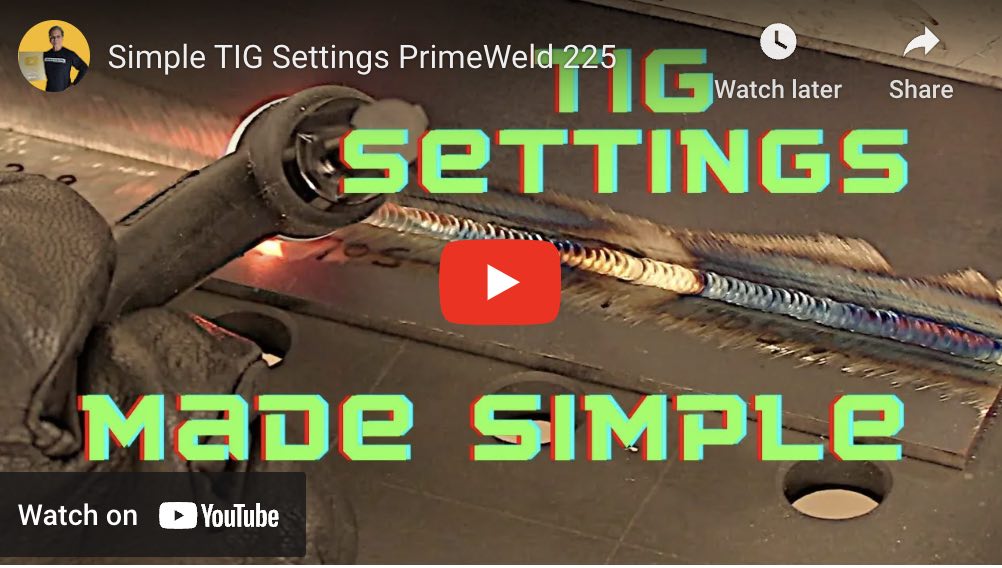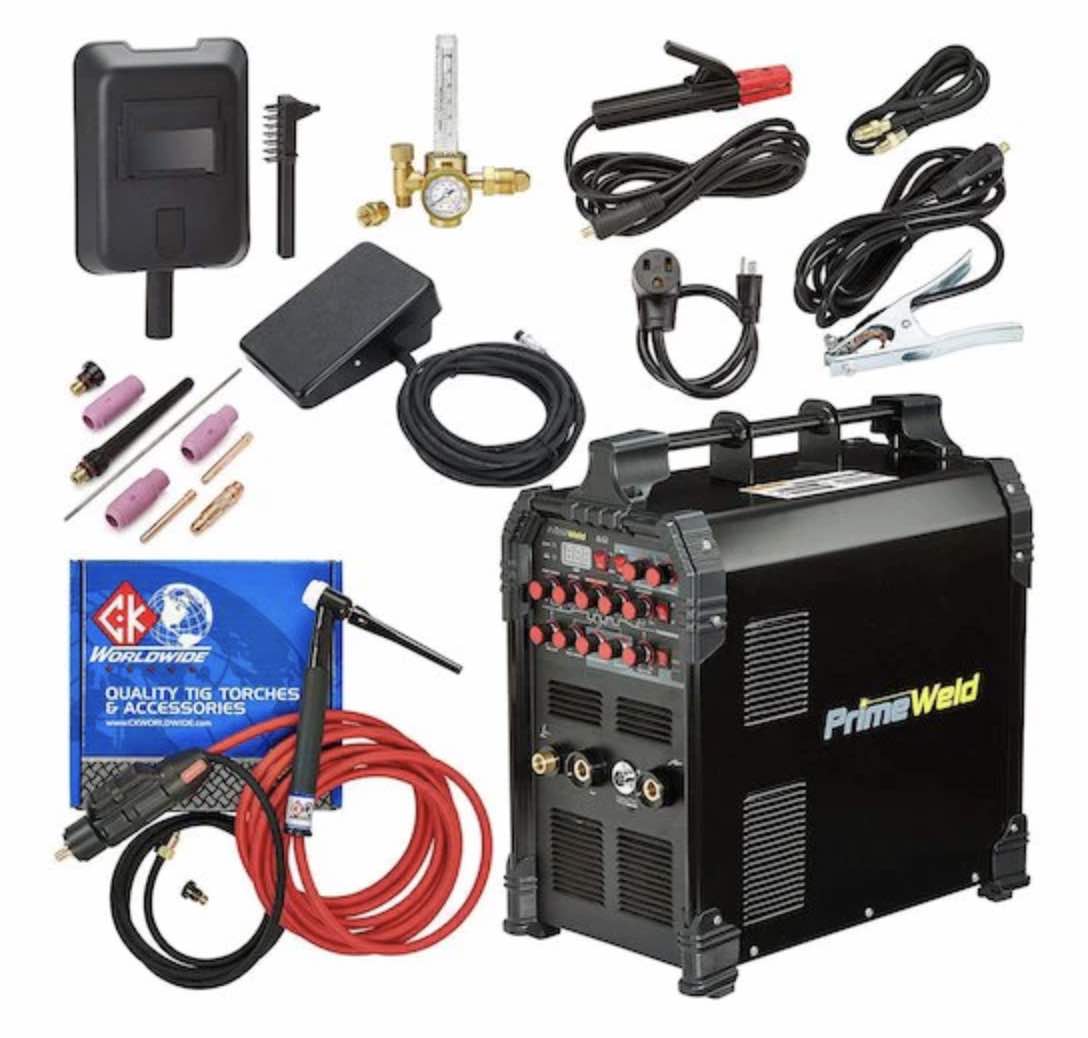PrimeWeld 225
I have several primeweld 225 videos here on tig welding steel and aluminum including videos that explain how to use all the settings on the primeweld 225
In my opinion, the primeweld 225 is one of the best choices in affordable tig welders.
The problem with most other really affordable tig welders is usually the foot pedal and the torch are just bad and clunky.
Primeweld went to extra expense to include genuine ck torches with superflex hoses along with a smooth SSC style foot pedal.
They also have a responsive primeweld equipment users group on facebook and also have demonstrated great customer support
Watch some primeweld videos and you will see what I mean.
Learn more about this affordable tig welder with bonus kit at weldmonger.com
- HOME
- TIG WELDING
- Primeweld 225
I never really understood why Miller made their diversion tig welders with fixed ac balance, fixed ac frequency, and a hard wired tig torch.
I guess they were just going after the beginner market... but not being able to adjust aluminum settings, easily swap tig torches, or switch easily to stick welding mode,... seem like taking away too many options.
This is just my opinion but I think any modern TIG welder should have fully adjustable AC balance and AC frequency for TIG welding aluminum...and also have the ability to easily burn a stick rod.
Especially since there are plenty of videos now that show how to set AC balance and AC frequency. (There are several videos here at weldingtipsandtricks.com that explain exactly how to set ac balance and frequency)
Dual voltage capability should also be standard with any tig inverter.
Having the ability to weld off 115volt power for small portable jobs is a great option that can help you make money.
And since almost all tig inverters will also stick weld, that gives you even more options.
Things to look for when shopping for a tig inverter
When shopping for a TIG inverter, several key features and specifications can help you find a machine that suits your needs. Here’s a list of things to consider:
### 1. **Power Output and Amperage Range**
- **Amperage Range**: Ensure the welder has a wide amperage range, typically from 5-200 amps, to handle both thin and thick materials.
- **Duty Cycle**: Look for a machine with a high duty cycle, which indicates how long the welder can operate at a given amperage before needing to cool down.
### 2. **AC/DC Capability**
- **AC (Alternating Current)**: Necessary for welding aluminum and magnesium...and a few other applications like pot metal and using aluminum bronze filler metal on cast iron.
- **DC (Direct Current)**: Used for welding steel, stainless steel, and other metals. An AC/DC machine provides greater versatility.
### 3. **Pulse Feature**
- **Pulse Welding**: not always needed but Helps control heat input and manage weld bead appearance, particularly useful for thin materials and detailed work.
### 4. **HF Start or Lift-Start**
- **HF Start**: Uses high-frequency current to start the arc without touching the workpiece, reducing contamination.
HF start is a great feature and once you have it, you don't want to go back to lift arc.
- **Lift-Start**: Requires touching the tungsten to the workpiece to start the arc, which can be a simpler and more affordable option but may introduce contamination. (also sometimes needed to avoid high freq interference with electronics or equipment)
### 5. **Foot Pedal and Torch Controls**
- **Foot Pedal**: Allows for precise control of the welding current while welding, making it easier to adjust heat input on the fly.
- **Torch Controls**: Some inverters come with torches that have built-in controls for convenience and flexibility.
There is also an option of using a torch switch without amperage control but a foot pedal provides the most control.
### 6. **Portability**
- **Weight and Size**: If you need to move your welder frequently, consider a lightweight and compact design. Inverter-based TIG welders are generally more portable than traditional transformer-based machines.
### 7. **Cooling System**
- **Air-Cooled vs. Water-Cooled**: Air-cooled systems are simpler and adequate for most applications, but water-cooled torches can handle higher amperages and prolonged welding sessions without overheating.
Typically aluminum 1/4" thick and thicker will make an air cooled tig torch too hot to hold and at that point you might want to upgrade to a water cooled torch and cooler.
The primeweld 225 had a power plug in the back of the unit to power the cooler.
### 8. **Quality of Components**
- **Build Quality**: Look for machines with robust construction and durable components. Check reviews and manufacturer reputation for reliability.
- **Warranty and Support**: A good warranty and responsive customer support can save you time and money if something goes wrong.
### 9. **Ease of Use**
- **User Interface**: Simple and intuitive controls are beneficial, especially for beginners. Digital displays and easy-to-navigate settings can make a big difference. There are videos on this website and at my blog at weldmonger.com that demostrate all the settings on the primeweld 225
### 10. **Additional Features**
- **Memory Settings**: Some inverters allow you to save your favorite settings for quick recall.
- **Arc Stability**: more expensive machines offer features like AC waveforms, and amplitude offset and while these features are nice, they are not needed by most folks. The primeweld 225 has the basic features you need for making high end aluminum welds.
### 11. **Price and Budget**
- **Cost vs. Features**:you can spend well over 10k on a tig machine.
the primeweld 225 is an affordable option that comes in well under $1000 and even with a water cooler and ck water cooled torch, is only around $1600.
### 12. **Reviews and Recommendations**
- **User Reviews**: Read reviews and testimonials from other welders to gauge real-world performance and reliability.
- **Expert Recommendations**: Seek advice from experienced welders or professionals who can provide insights based on practical use.
By considering these factors, you can find a TIG inverter that meets your specific welding needs and provides reliable performance for your projects.

















